St Benet Fink Church, Tottenham facts for kids
Quick facts for kids St Benet Fink |
|
|---|---|
| Parish Church of St Benet Fink | |
 |
|
| 51°35′51″N 0°05′28″W / 51.5973744°N 0.0910583°W | |
| OS grid reference | TQ3290 |
| Country | |
| Denomination | Church of England |
| Churchmanship | Traditional Catholic |
| Website | www.stbenetfink.org.uk |
| History | |
| Status | Church |
| Founded | June 3, 1911 - but see note below |
| Dedication | Saint Benedict |
| Consecrated | 1912-05-15 |
| Architecture | |
| Functional status | Active |
| Architectural type | Mini-Cathedral |
| Groundbreaking | 1911-06-03 |
| Specifications | |
| Length | 41 metres (135 ft) |
| Width | 18 metres (59 ft) |
| Nave width | 11 metres (36 ft) |
| Number of spires | One |
| Materials | Red brick walls, slate roof. |
| Administration | |
| Parish | St. Benet Fink, Tottenham |
| Deanery | Haringey |
| Archdeaconry | Hampstead |
| Episcopal area | Edmonton |
| Diocese | London |
| Province | Canterbury |
St Benet Fink, Tottenham, is an Anglican church located in Tottenham, London. It is a place of worship for people in the local community.
Contents
History of St Benet Fink
The Original Church
The first St Benet Fink church was not in Tottenham. It was in a different part of London called Threadneedle Street. Records show this church existed as early as 1216. Before that, a church dedicated to Saint Benedict was rebuilt with money from a person named Robert Finke.
How the Church Got Its Name
The name "Benet" is a shorter way of saying "Benedict," which comes from Saint Benedict. In the past, if there were many churches named after the same saint in one area, people would add the name of a special helper or founder to the church's name. This helped tell them apart. So, "Benet Fink" means "Saint Benedict's Church, helped by Finke."
Building the Current Church
In 1904, a special group started working in this area of Tottenham. They opened a temporary church in 1905, which was a simple building made of tin, while they collected money for a permanent one. The church you see today was built between 1911 and 1912.
It was officially opened on May 15, 1912. The Bishop of London, a very important church leader, called it "the little Cathedral." This was because its inside felt bright and open, much like a large Gothic cathedral. The architect who designed it was J. S. Alder. Many people say St Benet's is his most complete church, meaning it looks very much like he planned it, without many changes over time.
The church has a tall, pointed roof part called a spire. Inside the spire, there is one bell. This was a common design for churches built around that time. The building is also listed as Grade II, which means it is an important historic building that needs to be protected. The beautiful designs in the church windows show symbols of important saints and martyrs from early Christian history.
Church Design and Features
The church is built with red bricks and has a roof made of slate. It features a small spire that holds a single bell. This style of building was very popular in north London in the early 1900s. Next to the church, there is also a matching house for the vicar (the church leader) and a church hall, which is used for community events.


